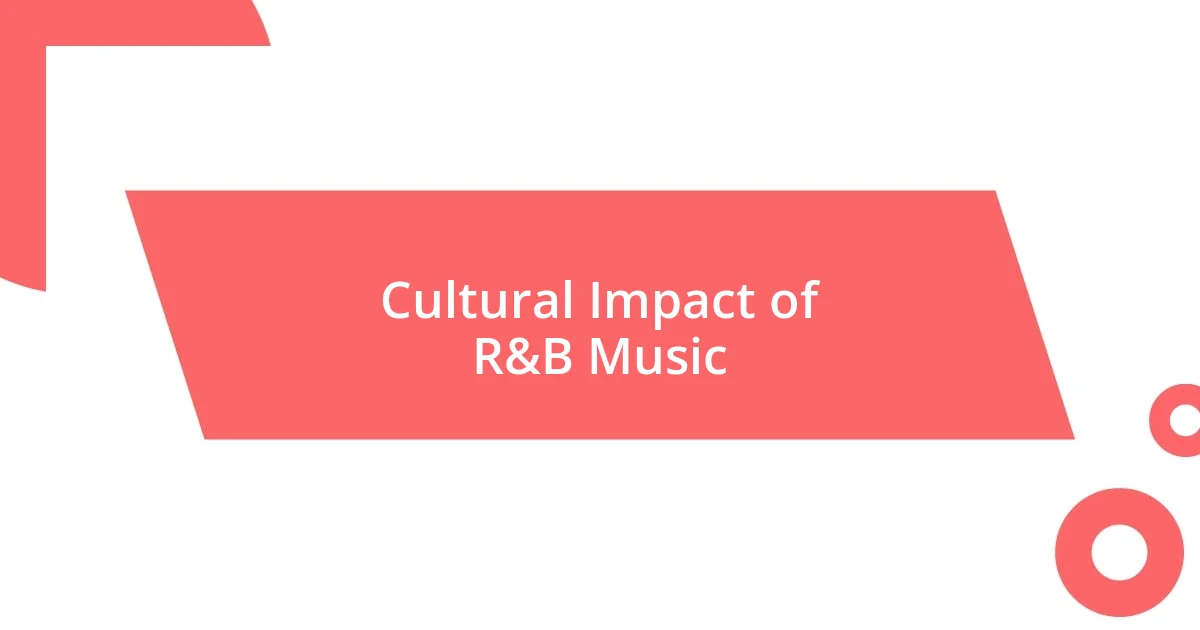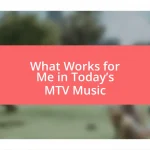Key takeaways:
- MTV’s promotion of R&B in the ’90s fostered representation and emotional connection, highlighting the genre’s powerful storytelling.
- Artists like Mary J. Blige, Aaliyah, and Usher reshaped R&B, blending traditional and modern elements while influencing fashion and cultural trends.
- Modern musicians can learn from MTV’s focus on authenticity, fan engagement, and visual storytelling to create deeper connections with audiences.

Understanding MTV’s R&B Influence
MTV’s embrace of R&B in the ’90s wasn’t just about music; it was a cultural shift. I still remember the first time I saw artists like Mary J. Blige and Boyz II Men take over the network. Their soulful melodies and powerful performances brought such a fresh energy that I found myself captivated, not just by their talent, but by how they connected with the audience emotionally.
Watching R&B artists break into the mainstream made me reflect on the power of representation. It felt exhilarating to see a genre that resonated deeply with so many being showcased on a platform as influential as MTV. Hasn’t it always been crucial for us to see ourselves reflected in the media? Those moments helped shape my understanding of how diversity in music can foster a sense of belonging and community.
R&B on MTV also highlighted the genre’s unique storytelling ability. Each song seemed to transport me to a personal narrative, whether through heartbreak or celebration. I often find myself asking, how did these artists manage to convey such raw emotion? It’s a testament to their craft and the genre’s rich roots that continue to inspire new generations, creating a lasting impact that is hard to quantify.

Key Artists Shaping the Genre
R&B has been shaped by a variety of key artists who have brought their unique sounds and experiences to the forefront. I still remember the first time I heard a track by Aaliyah; there was something ethereal about her voice that drew me in instantly. Her blend of contemporary beats with classic R&B told a story of love and loss that felt so relatable. It’s artists like her, along with legends like Usher and Toni Braxton, who have pushed the genre to evolve while maintaining its emotional core.
Here are some influential artists who have left a lasting mark on R&B:
- Mary J. Blige: Known as the “Queen of Hip-Hop Soul,” she effortlessly melds R&B with rap.
- Boyz II Men: Their harmonies and heartfelt lyrics redefined vocal groups, making ballads a staple in R&B.
- Aaliyah: She introduced a more modern, sultry sound that paved the way for future artists, influencing many with her innovative production.
- Usher: With his smooth vocals and iconic dance moves, Usher has kept R&B fresh and popular through the decades.
- Toni Braxton: Famous for her contralto voice and emotional delivery, she brought a theatrical quality to her songs, creating powerful anthems.
- D’Angelo: His introspective lyrics and blend of funk and soul have inspired a new wave of R&B musicians.

MTV’s Role in Artist Promotion
MTV revolutionized the way artists were promoted, especially during the ’90s. One aspect that stood out to me was the visual storytelling that accompanied music videos. I still remember how a well-crafted video could elevate a song into the stratosphere of popularity. Visuals added layers of meaning, allowing me to see the artist’s vision come to life. It was fascinating to watch R&B acts shape their identities through striking imagery, which made their music even more relatable and memorable.
The network also created unique platforms for artists to engage directly with their audience. I recall the excitement surrounding “MTV Unplugged” sessions, which allowed artists like Lenny Kravitz and Erykah Badu to showcase their raw talent. These intimate performances made me appreciate their artistry on a deeper level. Experiencing these stripped-back versions of iconic songs connected fans to the artists’ true essence in a way that polished studio productions often can’t achieve.
In today’s digital landscape, MTV’s early strategies still resonate with how artists use multimedia to build their brands. I find it intriguing how artists now harness social media to promote their music, yet the core principle remains the same: genuine connection with fans. I often wonder, what would the R&B scene look like today if artists didn’t have that MTV platform to launch from? It’s heartening to reflect on how the network helped shape careers and fostered an enduring love for R&B, influencing countless listeners, including myself.
| Aspect | MTV’s Influence |
|---|---|
| Artist Promotion | Utilized music videos for promotional storytelling |
| Engagement | Created platforms for direct fan engagement like ‘MTV Unplugged’ |
| Legacy | Paved the way for today’s multi-platform artist promotion strategies |

Cultural Impact of R&B Music
The cultural impact of R&B music is profound and expansive. I remember the first time I heard Mary J. Blige’s “Real Love.” It hit me hard; it felt like she was voicing the struggles of so many people. The way she seamlessly mixed heartfelt lyrics with a hip-hop beat created a relatable sound that spoke directly to my experiences and those of my friends. R&B, in this way, acts as a mirror reflecting the joys and sorrows of everyday life.
It’s fascinating to see how R&B has influenced fashion and lifestyle trends as well. When I think of Boyz II Men, I can’t help but recall how their stylish looks and smooth choreography were all the rage in the ’90s. Their music wasn’t just a soundtrack; it shaped our perceptions of romance and relationship dynamics. I often ask myself: how much did their iconic style inspire the way we dressed for dates or special outings? I believe it paved the way for blending music and personal style, influencing generations in expressing themselves.
R&B also evokes a sense of community and unity. Whether at house parties or music festivals, I’ve watched people come together, singing and dancing to soulful melodies. I can’t recall a moment when Usher’s “Yeah!” didn’t turn an entire room into an energetic celebration. It brings to mind the power of music as a unifying force, transcending boundaries and connecting us through shared experiences. Isn’t it incredible how a single genre can create lasting memories and relationships?

Lessons for Modern Musicians
When I think about what modern musicians can take away from MTV’s impact, authenticity is a lesson that stands out. Artists like Aaliyah and Brandy thrived because they were genuine in expressing their emotions and experiences. It’s something I often reflect on—how important it is for artists today to stay true to themselves, even when the industry pushes for trends or marketability. Have you ever noticed how much more you connect with music that feels real? That sincerity resonates deeply with listeners.
Engagement with fans is another crucial takeaway. MTV’s ability to forge a connection between artists and their audience set a powerful precedent. I remember the fan interactions in shows like “Total Request Live”—it made me feel like I was part of a larger community. In the streaming era, musicians can still tap into this by leveraging platforms like Instagram Live or TikTok. I often think about how much more powerful it is when fans feel involved in the creative process. Don’t you feel more invested in an artist’s journey when they share their highs and lows with you?
Lastly, the visual element in storytelling is something I believe every modern artist should embrace. MTV taught us that a striking music video can elevate a song from just being played to becoming an unforgettable experience. I recall feeling captivated by the vivid colors and choreography of Destiny’s Child’s “Say My Name.” Those visuals made the emotions in the song even more poignant. Today, I urge aspiring musicians to think creatively about how visuals can enhance their storytelling. After all, in a visually-driven world, isn’t it vital to craft a strong visual identity alongside our music?

Applying Insights to Today’s Industry
The insights gained from R&B’s golden era are especially crucial for today’s music industry. I often think about how artists can channel their personal stories into their music. For instance, when I listen to H.E.R.’s “Focus,” it feels like I’m right there in the moment with her, grappling with emotions that we all understand. Isn’t it amazing how personal narratives can create such a strong bond between the listener and the artist?
Moreover, the importance of collaboration cannot be overstated. Just as producers and artists in the ’90s found synergy that led to dynamic sounds, modern musicians can benefit from collaborating across genres, something I’ve seen in recent tracks blending R&B with pop or even hip-hop. I recall how excited I was when Khalid teamed up with Normani for “Love Lies.” Their collaboration brought something fresh and exciting to the table. Isn’t it interesting how these partnerships can spark creativity and reach a wider audience?
Lastly, let’s not forget the role of social media as a powerful marketing tool. Artists like SZA leverage platforms like Twitter to engage their fans and share their thoughts candidly. I can’t help but feel that this direct connection fosters a sense of intimacy that traditional marketing simply can’t match. Have you ever felt like you knew an artist simply because you followed their journey online? It’s a game-changer in how artists can cultivate a loyal fanbase while remaining accessible and relatable.















